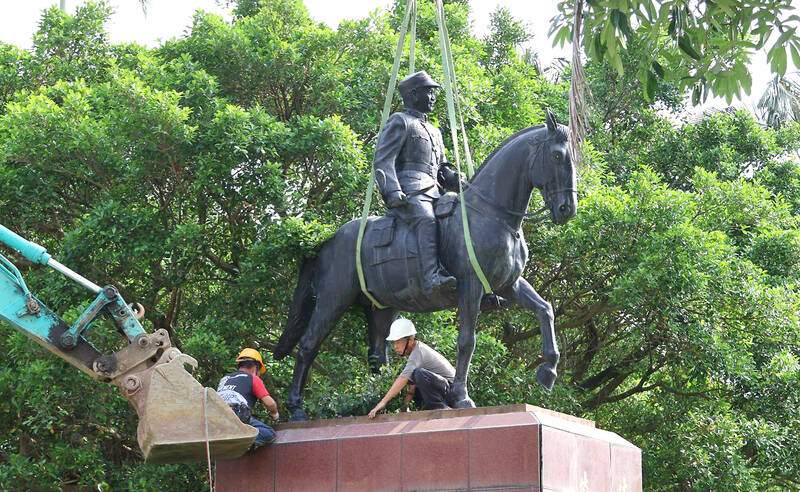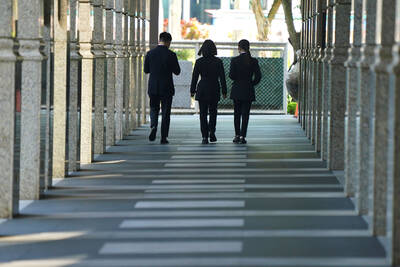The last time Mrs Hsieh came to Cihu Park in Taoyuan was almost 50 years ago, on a school trip to the grave of Taiwan’s recently deceased dictator. Busloads of children were brought in to pay their respects to Chiang Kai-shek (蔣中正), known as Generalissimo, who had died at 87, after decades ruling Taiwan under brutal martial law.
“There were a lot of buses, and there was a long queue,” Hsieh recalled. “It was a school rule. We had to bow, and then we went home.”
Chiang’s body is still there, under guard in a mausoleum at the end of a path that winds through misty bamboo past a still lake broken only by light drizzle and a drifting swan. But the other end of the park is the truly ghostly part, dotted as it is with hundreds of statues, almost all of Chiang.

Photo: Chiang Chih-hsiung, Taipei Times
Some stand in a circle — a group of Chiangs gathered for a casual conference or a campfire chat. Elsewhere, dozens are lined up in what looks like a choir of Chiangs. There is Chiang on a horse, Chiang in a seat, Chiang reading a book or holding a hat. A few have Chiang surrounded by adoring children, and paths are lined with his busts on concrete pedestals. Almost all the Chiangs wear his famous smile.
There were no statues here in the 1970s, says Hsieh. They have been moved here over time, taken from public spaces but not destroyed, standing here as an uncanny honor guard around the mausoleum.
“It’s a strange place,” says Hsieh. “There are so many statues. It would be scary at night.”
.jpg)
Photo: Paul Cooper, Taipei Times
The veneration shown to Chiang when Hsieh was a child is no longer a given. Chiang was the ruler of the Republic of China until he and his Chinese Nationalist Party (KMT) were driven out by the communists in China’s civil war. They and millions of supporters retreated to Taiwan in 1949, establishing the ROC in exile, with Chiang planning to retake China one day. Under his almost-four-decade-rule — now known as the “white terror” — an estimated 3,000-4,000 people were executed and 140,000 imprisoned for actual or perceived opposition to the KMT.
After his death in 1975, Taiwan transitioned to a democracy, and criticism of the leadership present and past became possible. But Chiang’s legacy is still fervently debated here.
In 2018, the ruling Democratic Progressive party (DPP), which was born of the opposition to martial law, established a transitional justice commission to investigate and atone for the KMT’s acts against Taiwan’s people. In 2022, a subsidy program offered grants of up to NT$100,000 for local authorities to change or remove “authoritarian symbols” to help end a “culture of political veneration.”
Taiwan has more than 300 roads named after Chiang, almost 60 schools and dozens of localities, including the central district of Taipei. A handful have changed name in the past five years: a road in former capital Tainan is now named after a prominent victim of the massacre of February 1947, when thousands of protesters were killed by KMT troops.
Last week, a DPP legislator challenged the government on its slow progress over the more than 700 statues that are still standing, saying it should be more proactive in encouraging take-up of the subsidies. Shih Pu (石樸), an official with the Executive Yuan’s Department of Human Rights and Transitional Justice, said part of the issue was that many of the statues were on military sites, which did not want to remove them.
The modern KMT, now in opposition, has apologized for past acts but opposes the DPP’s transitional justice efforts, which it says amount to a political witch-hunt. Some members have likened a proposal to remove the largest Chiang statue — a six-meter-high sculpture in central Taipei — to the Taliban’s destruction of the Buddhas of Bamiyan in 2001.
Opinions are divided but nuanced. Prominent campaigner Lin Lee-tsai , whose father was a victim of the massacres, said her family will “set off firecrackers” if the Taipei statue is removed. But some say Chiang’s crimes must be balanced against the economic boom he ushered through, and his fight against the Japanese and the communists.
“Chiang did a lot of controversial things,” park visitor Mr Huang said. “But he also made contributions. If he hadn’t come to Taiwan back then, it would probably be ruled by the communists now, and most Taiwanese do not want to be governed by Xi Jinping (習近平).”
Hsieh says there’s no point erasing history, and the statues look OK where they are in schools. Also, she adds, laughing, Cihu park is spooky enough. It doesn’t need any more.

JUNE 30 to JULY 6 After being routed by the Japanese in the bloody battle of Baguashan (八卦山), Hsu Hsiang (徐驤) and a handful of surviving Hakka fighters sped toward Tainan. There, he would meet with Liu Yung-fu (劉永福), leader of the Black Flag Army who had assumed control of the resisting Republic of Formosa after its president and vice-president fled to China. Hsu, who had been fighting non-stop for over two months from Taoyuan to Changhua, was reportedly injured and exhausted. As the story goes, Liu advised that Hsu take shelter in China to recover and regroup, but Hsu steadfastly

Taiwan’s politics is mystifying to many foreign observers. Gosh, that is strange, considering just how logical and straightforward it all is. Let us take a step back and review. Thanks to the Chinese Nationalist Party (KMT) and the Taiwan People’s Party (TPP), starting this year people will once again have Christmas Day off work. In 2002, the Scrooges in the Democratic Progressive Party (DPP) said “bah, humbug” to that. The holiday is not actually Christmas, but rather Constitution Day, celebrating the enactment of the Constitution of the Republic of China (ROC) on December 25, 1947. The DPP and the then pan-blue dominated legislature

Focus Taiwan reported last week that government figures showed unemployment in Taiwan is at historic lows: “The local unemployment rate fell 0.02 percentage points from a month earlier to 3.30 percent in May, the lowest level for the month in 25 years.” Historical lows in joblessness occurred earlier this year as well. The context? Labor shortages. The National Development Council (NDC) expects that Taiwan will be short 400,000 workers by 2030, now just five years away. The depth of the labor crisis is masked by the hundreds of thousands of migrant workers which the economy absolutely depends on, and the

If you’ve lately been feeling that the “Jurassic Park” franchise has jumped an even more ancient creature — the shark — hold off any thoughts of extinction. Judging from the latest entry, there’s still life in this old dino series. Jurassic World Rebirth captures the awe and majesty of the overgrown lizards that’s been lacking for so many of the movies, which became just an endless cat-and-mouse in the dark between scared humans against T-Rexes or raptors. Jurassic World Rebirth lets in the daylight. Credit goes to screenwriter David Koepp, who penned the original Jurassic Park, and director Gareth Edwards, who knows